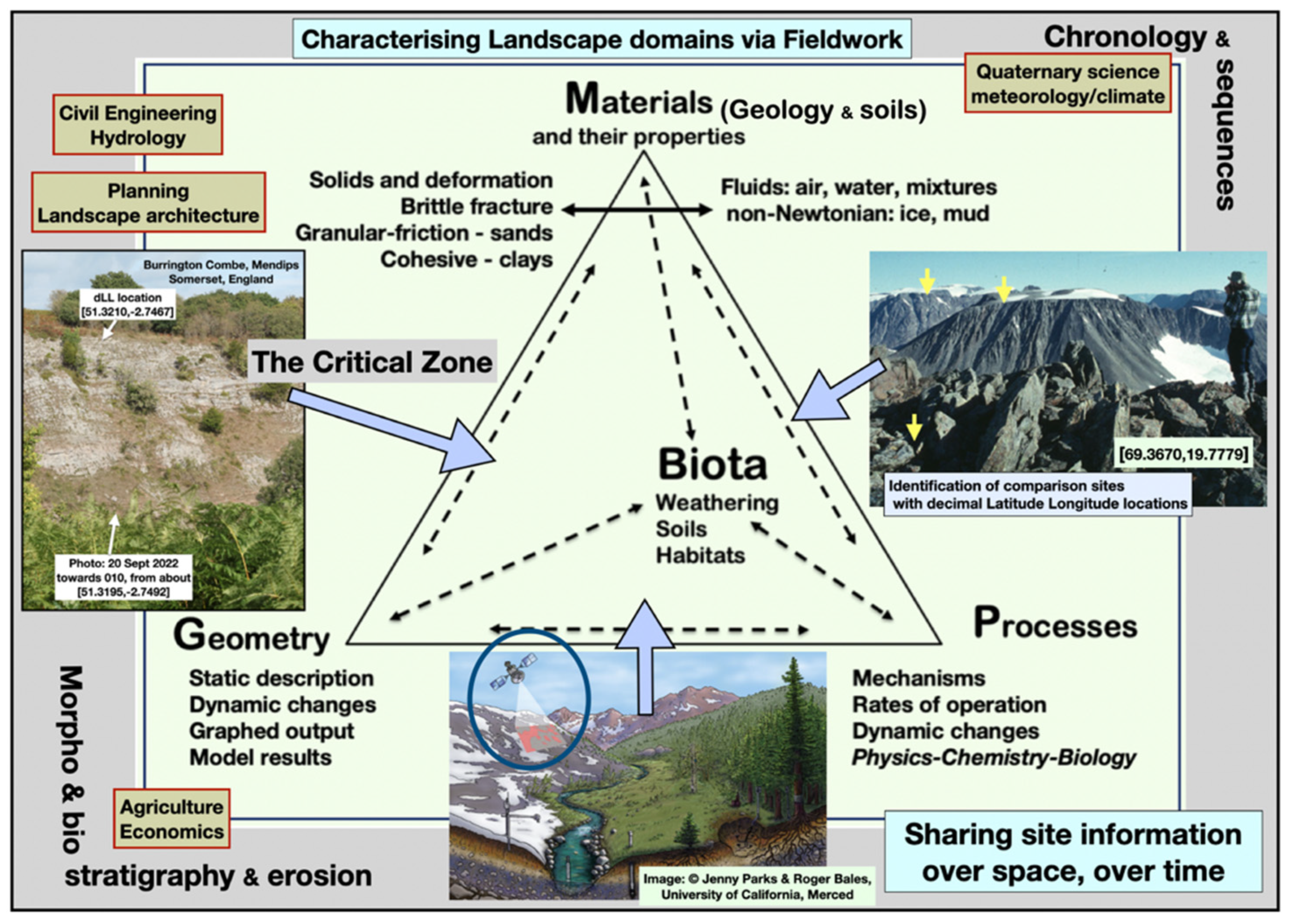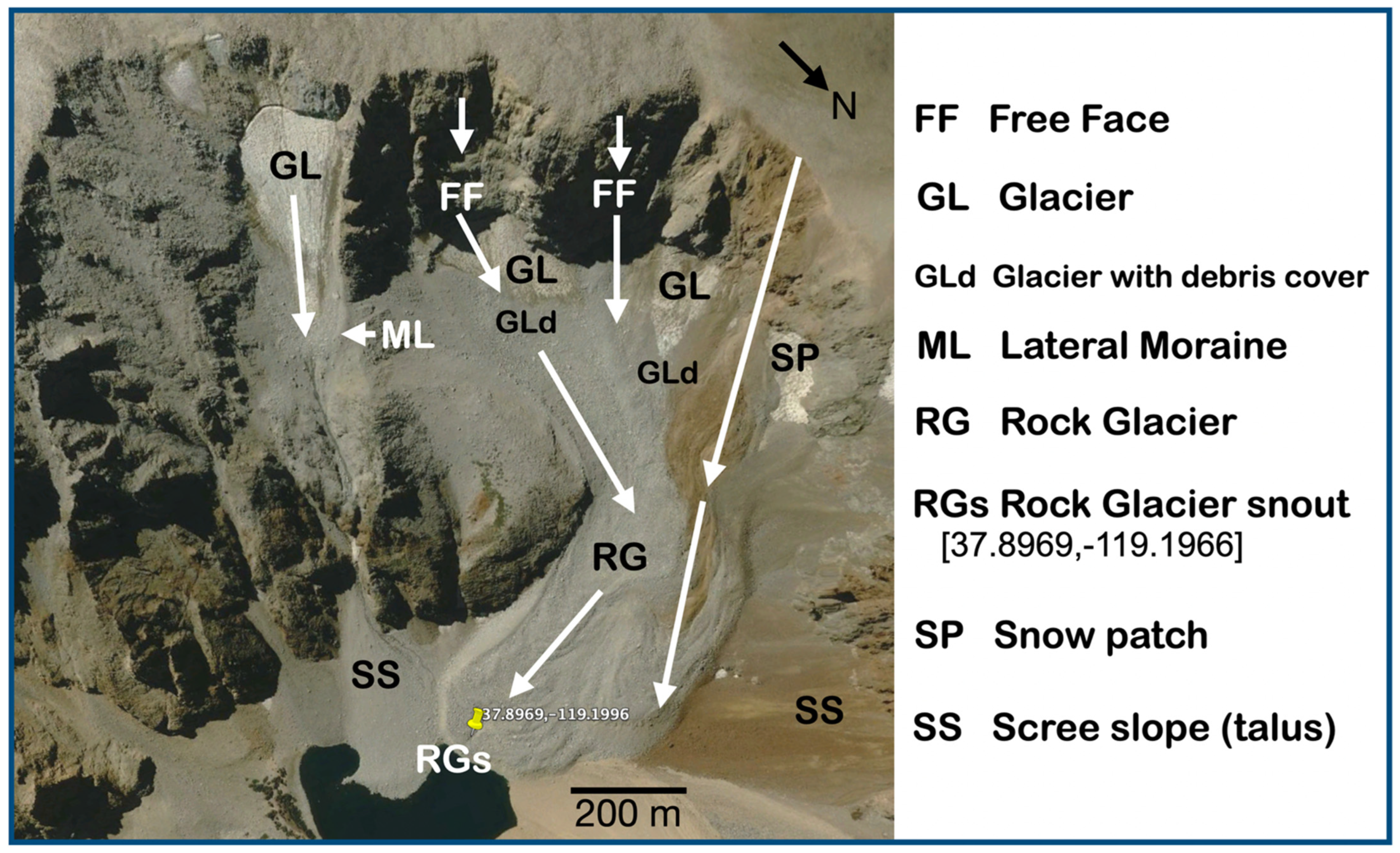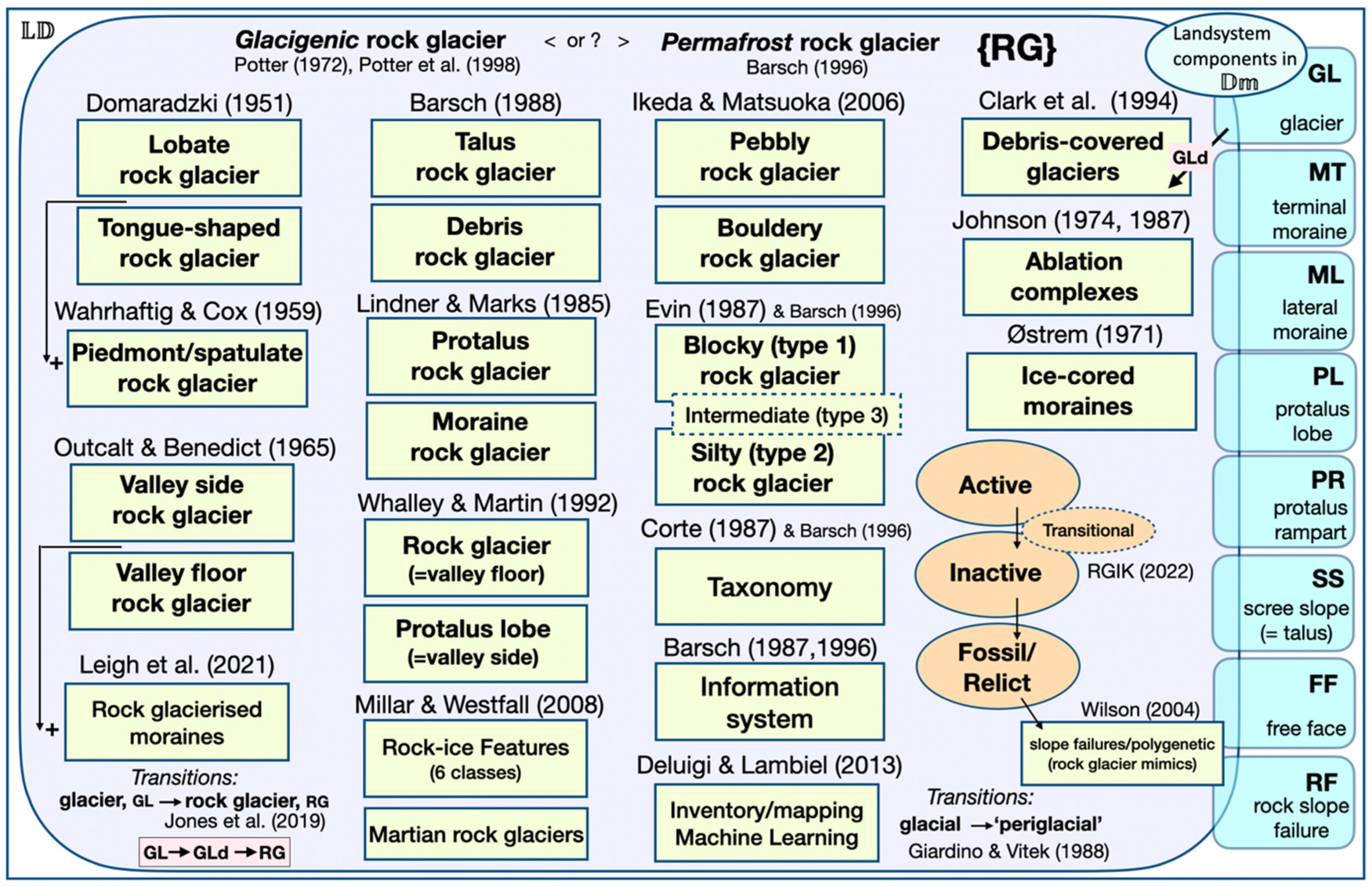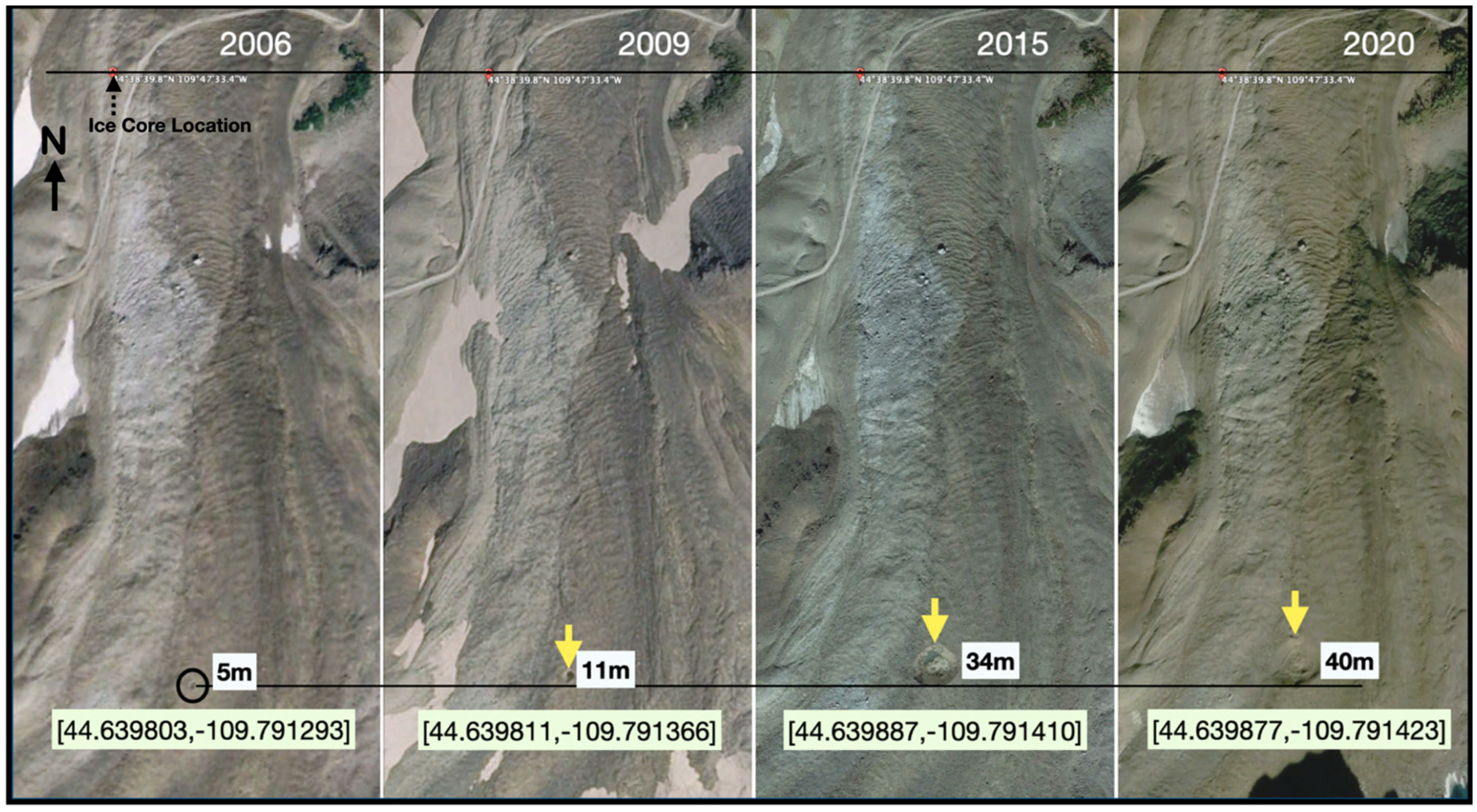Remote Sensing and Landsystems in the Mountain Domain: FAIR Data Accessibility and Landform Identification in the Digital Earth
Abstract
:1. Introduction
2. Background Concepts
2.1. Digital Earth
2.2. Decimal Degree Geolocation [dLL]
2.3. The Critical Zone
3. Considerations of Geolocation in Remote Sensing Applications
3.1. Landslides, Elevation Models and Geomorphic Identity
3.2. Information Aggregation in Information Landscapes
3.3. Entities in Landscapes
3.4. Rock Glaciers and [dLL] Geolocation
- What is an RG and how does it, or does not, relate to GL and GLd?
- What do RG signify environmentally and geomorphologically? The key question, are they permafrost or glacier ice bodies?
- How are RG distinguished on the Earth’s surface and can they be differentiated from glaciers, GL?
- How can RG, GL and GLd be used in inventories, e.g., to determine water content or extent of permafrost?
3.5. Identification of Glacier Ice-Cored Rock Glaciers
4. General Discussion
5. Conclusions
- The use of a uniformly recognized geolocation formal, [dLL], allows unique locations on the surface of the Earth to be identified and shared. It thus has an important part to play within the FAIR data usage doctrine.
- [dLL] can be used in image metadata to identify any object or feature as well as the vantage point of a field photograph.
- [dLL] can be used to identify a feature that might require repeated survey, perhaps over an appropriate time interval to ascertain change, e.g., vegetation. This might be a satellite sensor, ground control site or part of a UAV survey (Figure 1).
- A transect can be determined by a [dLL] as origin (Figure 2). This transect contains information (an information tensor) that can be linked to a resurvey or analysis with a new sensor. Transects, as with point locations, can be test sites for providing model checking or ground truth.
- [dLL] can provide the important links in data sets; [dLL]{other information, web sites etc, dates} as a searchable bundle in digital form. This is especially important when [dLL] are used as database reference objects or identifiers.
- Using [dLL] as datapoints allows data to be linked as nodes in knowledge graphs for visualization and analysis or in a GIS.
- Publications should enhance the FAIR data principles by using [dLL] in image metadata, data tables. The basic data set, including [dLL], should be included within the paper in a simple csv file to ensure compatibility with other investigations.
Funding
Data Availability Statement
Acknowledgments
Conflicts of Interest
References
- Aswathi, J.; Kumar, R.B.; Oommen, T.; Bouali, E.; Sajinkumar, K. InSAR as a tool for monitoring hydropower projects: A review. Energy Geosci. 2022, 3, 160–171. [Google Scholar] [CrossRef]
- Zwieback, S.; Liu, L.; Rouyet, L.; Short, N.; Strozzi, T. Advances in InSAR Analysis of Permafrost Terrain. Permafr. Periglac. Process. 2024, 1–13. [Google Scholar] [CrossRef]
- Whalley, W.B. Landscape Domains and Information Surfaces: Data Collection, Recording and Citation Using Decimal Latitude-Longitude Geolocation via the FAIR Principles. Earth Surf. Process. Landf. 2023, 48, 11. [Google Scholar] [CrossRef]
- International Symposium on Digital Earth. International Symposium on Digital Earth. International Symposium on Digital Earth–Digital Earth in Action. In Center for Earth Observation and Digital Earth; Chinese Academy of Sciences: Beijing, China, 2009; Available online: https://web.archive.org/web/20120227195943/http:/159.226.224.4/isde6en/hykx11.html (accessed on 10 June 2024).
- Whalley, W.B. Enhancing the Digital Earth via Digital Decimal Geolocation and the FAIR Data Principles. Earth Sci. Syst. Soc. 2024, 10110. [Google Scholar] [CrossRef]
- Gabrielli, S.; Spagnolo, M.; De Siena, L. Geomorphology and surface geology of Mount St. Helens Volcano. J. Maps 2020, 16, 585–594. [Google Scholar] [CrossRef]
- Sobolewski, L.; Hansteen, T.H.; Zorn, E.U.; Stenner, C.; Florea, L.J.; Burgess, S.A.; Ionescu, A.; Cartaya, E.; Pflitsch, A. The evolving volcano-ice interactions of Crater Glacier, Mount St. Helens, Washington (USA). Bull. Volcanol. 2023, 85, 22. [Google Scholar] [CrossRef]
- Giardino, J.R.; Houser, C. Principles and Dynamics of the Critical Zone; Elsevier: Amsterdam, The Netherlands, 2015. [Google Scholar]
- Diao, C. Complex network-based time series remote sensing model in monitoring the fall foliage transition date for peak coloration. Remote Sens. Environ. 2019, 229, 179–192. [Google Scholar] [CrossRef]
- Gaillardet, J.; Braud, I.; Gandois, L.; Probst, A.; Probst, J.-L.; Sanchez-Pérez, J.M.; Simeoni-Sauvage, S. OZCAR: The French network of critical zone observatories. Vadose Zone J. 2018, 17, 1–24. [Google Scholar] [CrossRef]
- Brantley, S.L.; Goldhaber, M.B.; Ragnarsdottir, K.V. Crossing disciplines and scales to understand the critical zone. Elements 2007, 3, 307–314. [Google Scholar] [CrossRef]
- Banwart, S.; Bernasconi, S.M.; Bloem, J.; Blum, W.; Brandao, M.; Brantley, S.; Chabaux, F.; Duffy, C.; Kram, P.; Lair, G. Soil processes and functions in critical zone observatories: Hypotheses and experimental design. Vadose Zone J. 2011, 10, 974–987. [Google Scholar] [CrossRef]
- Bishop, M.P.; Dobreva, I.B.; Houser, C. Geospatial Science and Technology for Understanding the Complexities of the Critical Zone. In Developments in Earth Surface Processes; Elsevier: Amsterdam, The Netherlands, 2015; pp. 523–561. [Google Scholar]
- White, T.; Brantley, S.; Banwart, S.; Chorover, J.; Dietrich, W.; Derry, L.; Lohse, K.; Anderson, S.; Aufdendkampe, A.; Bales, R. The Role of Critical Zone Observatories in Critical Zone Science. In Developments in Earth Surface Processes; Elsevier: Amsterdam, The Netherlands, 2015; pp. 15–78. [Google Scholar]
- Barrasa, J.; Webber, J. Building Knowledge Graphs. In A Practitioner’s Guide; O’Reilly: Sebastopol, CA, USA, 2023. [Google Scholar]
- Pei, Y.; Qiu, H.; Zhu, Y.; Wang, J.; Yang, D.; Tang, B.; Wang, F.; Cao, M. Elevation dependence of landslide activity induced by climate change in the eastern Pamirs. Landslides 2023, 20, 1115–1133. [Google Scholar] [CrossRef]
- Hu, Y.; Liu, L.; Huang, L.; Zhao, L.; Wu, T.; Wang, X.; Cai, J. Mapping and Characterizing Rock Glaciers in the Arid West Kunlun Mountains Supported by InSAR and DeepLearning. J. Geophys. Res. Earth Sci. 2023, 128, e2023JF007206. [Google Scholar] [CrossRef]
- Petley, D. The Landslide Blog. Available online: https://blogs.agu.org/landslideblog/ (accessed on 5 September 2023).
- Casagli, N.; Cigna, F.; Bianchini, S.; Hölbling, D.; Füreder, P.; Righini, G.; Del Conte, S.; Friedl, B.; Schneiderbauer, S.; Iasio, C. Landslide mapping and monitoring by using radar and optical remote sensing: Examples from the EC-FP7 project SAFER. Remote Sens. Appl. Soc. Environ. 2016, 4, 92–108. [Google Scholar] [CrossRef]
- Forkuor, G.; Maathuis, B. Comparison of SRTM and ASTER derived digital elevation models over two regions in Ghana-Implications for hydrological and environmental modeling. In Studies on Environmental and Applied Geomorphology; Piacentini, T., Miccadei, E., Eds.; INTECH: Rijeka, Yugoslavia, 2012. [Google Scholar] [CrossRef]
- Fleming, C.; Giles, J.; Marsh, S. Elevation Models for Geoscience; Special Publication 345; Geological Society of London: London, UK, 2010. [Google Scholar]
- Barr, I.D.; Dokukin, M.D.; Kougkoulos, I.; Livingstone, S.J.; Lovell, H.; Małecki, J.; Muraviev, A.Y. Using ArcticDEM to analyse the dimensions and dynamics of debris-covered glaciers in Kamchatka, Russia. Geosciences 2018, 8, 216. [Google Scholar] [CrossRef]
- Atkinson, J.; de Clercq, W.; Rozanov, A. Multi-resolution soil-landscape characterisation in KwaZulu Natal: Using geomorphons to classify local soilscapes for improved digital geomorphological modelling. Geoderma Reg. 2020, 22, e00291. [Google Scholar] [CrossRef]
- Pelletier, J. Quantitative Modeling of Earth Surface Processes; Cambridge University Press: Cambridge, UK, 2008. [Google Scholar]
- Jacquemart, M.; Weber, S.; Chiarle, M.; Chmiel, M.; Cicoira, A.; Corona, C.; Eckert, N.; Gaume, J.; Giacona, F.; Hirschberg, J. Detecting the impact of climate change on alpine mass movements in observational records from the European Alps. Earth-Sci. Rev. 2024, 104886. [Google Scholar] [CrossRef]
- Okoli, J.; Nahazanan, H.; Nahas, F.; Kalantar, B.; Shafri, H.Z.M.; Khuzaimah, Z. High-Resolution Lidar-Derived DEM for Landslide Susceptibility Assessment Using AHP and Fuzzy Logic in Serdang, Malaysia. Geosciences 2023, 13, 34. [Google Scholar] [CrossRef]
- Li, Z.; Cheng, W.; Xiao, H.; Yu, W.; Chen, H.; Wang, W. You are what and where you are: Graph enhanced attention network for explainable poi recommendation. In Proceedings of the 30th ACM International Conference on Information & Knowledge Management, 2021, Gold Coast, QLD, Australia, 1–5 November 2021; pp. 3945–3954. [Google Scholar] [CrossRef]
- Cunningham, F. James David Forbes, Pioneer Scottish Glaciologist; Scottish Academic Press: Edinburgh, UK, 1990. [Google Scholar]
- Grabner, H.; Gall, J.; Van Gool, L. What makes a chair a chair? In Proceedings of the Confderence on Computer Vision and Pattern Recognition 2011, Colorado Springs, CO, USA, 20–25 June 2011; pp. 1529–1536. [Google Scholar] [CrossRef]
- Raup, B.; Racoviteanu, A.; Khalsa, S.J.S.; Helm, C.; Armstrong, R.; Arnaud, Y. The GLIMS geospatial glacier database: A new tool for studying glacier change. Glob. Planet. Chang. 2006, 56, 101–110. [Google Scholar] [CrossRef]
- King, O.; Turner, A.G.; Quincey, D.J.; Carrivick, J.L. Morphometric evolution of Everest region debris-covered glaciers. Geomorphology 2020, 371, 107422. [Google Scholar] [CrossRef]
- Jones, D.B.; Harrison, S.; Anderson, K.; Shannon, S.; Betts, R. Rock glaciers represent hidden water stores in the Himalaya. Sci. Total Environ. 2021, 793, 145368. [Google Scholar] [CrossRef]
- Jones, D.B.; Harrison, S.; Anderson, K.; Whalley, W.B. Rock glaciers and mountain hydrology: A review. Earth-Sci. Rev. 2019, 193, 66–90. [Google Scholar] [CrossRef]
- Whalley, W.B. The glacier-rock glacier mountain landsystem: An example from North Iceland. Geogr. Ann. A 2021, 103, 1–22. [Google Scholar] [CrossRef]
- Barsch, D. Rockglaciers. In Indicators for the Present and Former Geoecology in High Mountain Environments; Springer: Berlin/Heidelberg, Germany, 1996; p. 331. [Google Scholar] [CrossRef]
- Millar, C.I.; Westfall, R.D. Rock glaciers and related periglacial landforms in the Sierra Nevada, CA, USA; inventory, distribution and climatic relationships. Quat. Int. 2008, 188, 90–104. [Google Scholar] [CrossRef]
- Liu, L.; Millar, C.I.; Westfall, R.D.; Zebker, H.A. Surface motion of active rock glaciers in the Sierra Nevada, California, USA: Inventory and a case study using InSAR. Cryosphere 2013, 7, 1109–1119. [Google Scholar] [CrossRef]
- Kaldybayev, A.; Sydyk, N.; Yelisseyeva, A.; Merekeyev, A.; Nurakynov, S.; Zulpykharov, K.; Issanova, G.; Chen, Y. The First Inventory of Rock Glaciers in the Zhetysu Alatau: The Aksu and Lepsy River Basins. Remote Sens. 2023, 15, 197. [Google Scholar] [CrossRef]
- Ma, Q.; Oguchi, T. Rock Glacier Inventory of the Southwestern Pamirs Supported by InSAR Kinematics. Remote Sens. 2024, 16, 1185. [Google Scholar] [CrossRef]
- Villarroel, C.D.; Tamburini Beliveau, G.; Forte, A.P.; Monserrat, O.; Morvillo, M. DInSAR for a Regional inventory of active rock glaciers in the dry andes mountains of argentina and chile with sentinel-1 data. Remote Sens. 2018, 10, 1588. [Google Scholar] [CrossRef]
- Zhang, J.; Jia, L.; Menenti, M.; Hu, G. Glacier facies mapping using a machine-learning algorithm: The Parlung Zangbo Basin case study. Remote Sens. 2019, 11, 452. [Google Scholar] [CrossRef]
- Lu, Y.; Zhang, Z.; Shangguan, D.; Yang, J. Novel machine learning method integrating ensemble learning and deep learning for mapping debris-covered glaciers. Remote Sens. 2021, 13, 2595. [Google Scholar] [CrossRef]
- Ganyushkin, D.; Chistyakov, K.; Derkach, E.; Bantcev, D.; Kunaeva, E.; Terekhov, A.; Rasputina, V. Glacier Recession in the Altai Mountains after the LIA Maximum. Remote Sens. 2022, 14, 1508. [Google Scholar] [CrossRef]
- Lizama, E.; Morales, B.; Somos-Valenzuela, M.; Chen, N.; Liu, M. Understanding landslide susceptibility in Northern Chilean Patagonia: A basin-scale study using machine learning and field data. Remote Sens. 2022, 14, 907. [Google Scholar] [CrossRef]
- Bertone, A.; Zucca, F.; Marin, C.; Notarnicola, C.; Cuozzo, G.; Krainer, K.; Mair, V.; Riccardi, P.; Callegari, M.; Seppi, R. An unsupervised method to detect rock glacier activity by using Sentinel-1 SAR interferometric coherence: A regional-scale study in the Eastern European Alps. Remote Sens. 2019, 11, 1711. [Google Scholar] [CrossRef]
- Meng, T.M.; Aguilar, R.; Christoffersen, M.S.; Petersen, E.I.; Larsen, C.F.; Levy, J.S.; Holt, J.W. Photogrammetric Monitoring of Rock Glacier Motion Using High-Resolution Cross-Platform Datasets: Formation Age Estimation and Modern Thinning Rates. Remote Sens. 2023, 15, 4779. [Google Scholar] [CrossRef]
- Khan, M.A.R.; Singh, S.; Pandey, P.; Bhardwaj, A.; Ali, S.N.; Chaturvedi, V.; Ray, P.K.C. Modelling permafrost distribution in western himalaya using remote sensing and field observations. Remote Sens. 2021, 13, 4403. [Google Scholar] [CrossRef]
- National Research Council of Canada (Ed.) Glossary of Permafrost and Related Ground-Ice Terms, Technical Memorandum 142; National Research Council of Canada: Ottawa, ON, Canada, 1988.
- Washburn, A.L. Geocryology: A Survey of Periglacial Processes and Environments; Wiley: Chichester, UK, 1979. [Google Scholar]
- Whalley, W.B. Mapping small glaciers, rock glaciers and related features in an age of retreating glaciers: Using decimal latitude-longitude locations and ‘geomorphic information tensors’. Geogr. Fis. E Din. Quat. 2021, 44, 55–67. [Google Scholar] [CrossRef]
- Haeberli, W. Creep of Mountain Permafrost: Internal structure and flow of alpine rock glaciers. Mitteilungen der Versuchsanstalt für Wasserbau. Hydrol. Glaziologie 1985, 77, 142. [Google Scholar]
- Barsch, D. The problem of ice-cored rock glacier. In Rock Glaciers; Giardono, J.R., Shroder, J.F., Vitek, J.D., Eds.; Allen and Unwin: London, UK, 1987; pp. 45–53. [Google Scholar]
- Deluigi, N.; Lambiel, C.; Kanevski, M. Data-driven mapping of the potential mountain permafrost distribution. Sci. Total Environ. 2017, 590, 370–380. [Google Scholar] [CrossRef]
- Barsch, D. Rockglaciers. In Advances in Periglacial Geomorphology; Clark, M.J., Ed.; Wiley: Chichester, UK, 1988; pp. 69–90. [Google Scholar]
- Clark, D.H.; Clark, M.M.; Gillespie, A.R. Debris-covered glaciers in the Sierra Nevada, California, and their implications for snowline reconstructions. Quat. Res. 1994, 41, 139–153. [Google Scholar] [CrossRef]
- Corte, A.E. Rock glacier taxonomy. In Rock Glaciers; Giardino, J.F., Jr., Shroder, J.F., Jr., Vitek, J.D., Eds.; Allen and Unwin: London, UK, 1987; pp. 27–39. [Google Scholar]
- Deluigi, N.; Lambiel, C. PERMAL: A Machine Learning Approach for Alpine Permafrost Distribution Modeling. Jahrestagung der Schweiz. Geomorph. Ges. 2013. Available online: https://www.researchgate.net/publication/267393953_PERMAL_a_machine_learning_approach_for_alpine_permafrost_distribution_modeling (accessed on 10 June 2024).
- Domaradzki, J. Blockströme in Kanton Graubunden. Ergebnisse Wissenschaftlichen Untersuchungen im Schweiz. Nationalpark 1951, 3, 177–235. Available online: https://www.parcs.ch/snp/pdf_public/1588_domaradzki_blockstroeme_nf_1951.pdf (accessed on 10 June 2024).
- Evin, M. Lithology and fracturing control of rock glacier in southwestern Alps of France and Italy. In Rock Glaciers; Giardino, J.F., Jr., Shroder, J.F., Jr., Vitek, J.D., Eds.; Allen and Unwin: London, UK, 1987; pp. 83–106. [Google Scholar]
- Giardino, J.R.; Vitek, J.D. The significance of rock glaciers in the glacial-periglacial landscape continuum. J. Quat. Sci. 1988, 3, 97–103. [Google Scholar] [CrossRef]
- Ikeda, A.; Matsuoka, N. Pebbly versus bouldery rock glaciers: Morphology, structure and processes. Geomorphology 2006, 73, 279–296. [Google Scholar] [CrossRef]
- Johnson, P.G. Mass movement of ablation complexes and their relationship to rock glaciers. Geogr. Ann. A. 1974, 93–101. [Google Scholar] [CrossRef]
- Johnson, P.G. Rock Glacier: Glacier Debris Systems or High-Magnitude Low-Frequency Flows; Allen and Unwin: London, UK, 1987; pp. 175–192. [Google Scholar]
- Jones, D.B.; Harrison, S.; Anderson, K. Mountain glacier-to-rock glacier transition. Global Plan. Chang. 2019, 102999. [Google Scholar] [CrossRef]
- Leigh, J.; Evans, D.; Stokes, C.; Andreassen, L.; Carr, R. Glacial and periglacial geomorphology of central Troms and Finnmark county, Arctic Norway. J. Maps 2021, 17, 348–366. [Google Scholar] [CrossRef]
- Lindner, L.; Marks, L. Types of debris slope accumulations and rock glaciers in South Spitsbergen. Boreas 1985, 14, 139–153. [Google Scholar] [CrossRef]
- Potter, J.N.; Steig, E.; Clark, D.; Speece, M.; Clark, G.T.; Updike, A.B. Galena Creek rock glacier revisited—New observations on an old controversy. Geogr. Ann. Ser. A Phys. Geogr. 1998, 80, 251–265. [Google Scholar] [CrossRef]
- Potter, N. Ice-cored rock glacier, Galena Creek, northern Absaroka Mountains, Wyoming. Geol. Soc. Am. Bull. 1972, 83, 3025–3058. [Google Scholar] [CrossRef]
- Østrem, G. Rock glaciers and ice-cored moraines, a reply to D. Barsch. Geogr. Ann. A 1971, 53, 207–213. [Google Scholar] [CrossRef]
- Outcalt, S.I.; Benedict, J.B. Photo-interpretation of two types of rock glacier in the Colorado Front Range, USA. Journal of Glaciology 1965, 5, 849–856. [Google Scholar] [CrossRef]
- RGIK. IPA Action Group Rock Glacier Inventories and Kinematics. Towards Standard Guidelines for Inventorying Rock Glaciers: Baseline Concepts (Version 4.2.2). Report. 2022. Available online: https://folia.unifr.ch/global/documents/327247 (accessed on 26 August 2024).
- Wahrhaftig, C.; Cox, A. Rock glaciers in the Alaska Range. Geol. Soc. Am. Bull 1959, 70, 383–436. [Google Scholar] [CrossRef]
- Whalley, W.B.; Martin, H.E. Rock glaciers: II models and mechanisms. Prog. Phys. Geogr. 1992, 16, 127–186. [Google Scholar] [CrossRef]
- Wilson, P. Relict rock glaciers, slope failure deposits, or polygenetic features? A reassessment of some Donegal debris landforms. Ir. Geogr. 2004, 37, 77–87. [Google Scholar] [CrossRef]
- RGIK. RGIK—Kinematic Approach: Rock Glacier Inventory using InSAR (Kinematic Approach), Practical Guidelines (Version 3.0.2). IPA Action Group Rock Glacier Inventories and Kinematics. 2020. Available online: https://bigweb.unifr.ch/Science/Geosciences/Geomorphology/Pub/Website/CCI/Guidelines/RGI_ka_InSAR-based_Guidelines_v.3.0.2.pdf (accessed on 26 August 2024).
- Brardinoni, F.; Scotti, R.; Sailer, R.; Mair, V. Evaluating sources of uncertainty and variability in rock glacier inventories. Earth Surf. Process. Landf. 2019, 44, 2450–2466. [Google Scholar] [CrossRef]
- Bertone, A.; Barboux, C.; Bodin, X.; Bolch, T.; Brardinoni, F.; Caduff, R.; Christiansen, H.H.; Darrow, M.M.; Delaloye, R.; Etzelmüller, B. Incorporating InSAR kinematics into rock glacier inventories: Insights from 11 regions worldwide. Cryosphere 2022, 16, 2769–2792. [Google Scholar] [CrossRef]
- de Pasquale, G.; Valois, R.; Schaffer, N.; MacDonell, S. Contrasting geophysical signatures of a relict and an intact Andean rock glacier. Cryosphere 2022, 16, 1579–1596. [Google Scholar] [CrossRef]
- Chakravarti, P.; Jain, V.; Mishra, V. The distribution and hydrological significance of intact rock glaciers in the north-west Himalaya. Geogr. Ann. Ser. A Phys. Geogr. 2022, 104, 226–244. [Google Scholar] [CrossRef]
- Abdullah, T.; Romshoo, S.A. A Comprehensive Inventory, Characterization, and Analysis of Rock Glaciers in the Jhelum Basin, Kashmir Himalaya, Using High-Resolution Google Earth Data. Water 2024, 16, 2327. [Google Scholar] [CrossRef]
- Zhang, X.; Feng, M.; Xu, J.; Yan, D.; Wang, J.; Zhou, X.; Li, T.; Zhang, X. Kinematic inventory of rock glaciers in the Nyainqêntanglha Range using the MT-InSAR method. Int. J. Digit. Earth 2023, 16, 3923–3948. [Google Scholar] [CrossRef]
- Cai, J.; Wang, X.; Liu, G.; Yu, B. A Comparative Study of Active Rock Glaciers Mapped from Geomorphic-and Kinematic-Based Approaches in Daxue Shan, Southeast Tibetan Plateau. Remote Sens. 2021, 13, 4931. [Google Scholar] [CrossRef]
- Whalley, W.B. Glacier–Rock Glacier Interactions in the Eastern Hindu Kush, Nuristan, Afghanistan [35.92,71.13] in the Period 1976–2019. Geogr. Ann. A 2024, 1–30. [Google Scholar] [CrossRef]
- Petersen, E.I.; Levy, J.S.; Holt, J.W.; Stuurman, C.M. New insights into ice accumulation at Galena Creek Rock Glacier from radar imaging of its internal structure. J. Glaciol. 2020, 66, 1–10. [Google Scholar] [CrossRef]
- Rodriguez, M.; Ohlanders, N.; Pellicciotti, F.; Williams, M.W.; McPhee, J. Estimating runoff from a glacierized catchment using natural tracers in the semi-arid Andes cordillera. Hydrol. Process. 2016, 30, 3609–3626. [Google Scholar] [CrossRef]
- Bowden, R.A. Building Confidence in Geological Models; Special Publications; Geological Society: London, UK, 2004; Volume 239, pp. 157–173. [Google Scholar] [CrossRef]
- Whalley, W.B.; Azizi, F. Rheological models of active rock glaciers: Evaluation, critique and a possible test. Permafr. Periglac. Process. 1994, 5, 37–51. [Google Scholar] [CrossRef]
- Whalley, W.B.; Azizi, F. Rock glaciers and protalus landforms: Analogous forms and ice sources on Earth and Mars. J. Geophys. Res. Planets 2003, 108, 8032. [Google Scholar] [CrossRef]





Disclaimer/Publisher’s Note: The statements, opinions and data contained in all publications are solely those of the individual author(s) and contributor(s) and not of MDPI and/or the editor(s). MDPI and/or the editor(s) disclaim responsibility for any injury to people or property resulting from any ideas, methods, instructions or products referred to in the content. |
© 2024 by the author. Licensee MDPI, Basel, Switzerland. This article is an open access article distributed under the terms and conditions of the Creative Commons Attribution (CC BY) license (https://creativecommons.org/licenses/by/4.0/).
Share and Cite
Whalley, W.B. Remote Sensing and Landsystems in the Mountain Domain: FAIR Data Accessibility and Landform Identification in the Digital Earth. Remote Sens. 2024, 16, 3348. https://doi.org/10.3390/rs16173348
Whalley WB. Remote Sensing and Landsystems in the Mountain Domain: FAIR Data Accessibility and Landform Identification in the Digital Earth. Remote Sensing. 2024; 16(17):3348. https://doi.org/10.3390/rs16173348
Chicago/Turabian StyleWhalley, W. Brian. 2024. "Remote Sensing and Landsystems in the Mountain Domain: FAIR Data Accessibility and Landform Identification in the Digital Earth" Remote Sensing 16, no. 17: 3348. https://doi.org/10.3390/rs16173348




